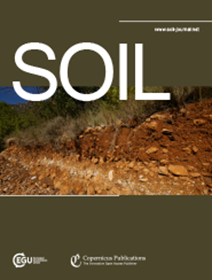不同天气情景下植物和土壤微生物的碳稳定性的硅分析
IF 4.3
2区 农林科学
Q1 SOIL SCIENCE
引用次数: 0
摘要
摘要。植物的发育与土壤-植物-大气连续体中的水和碳(C)流动密切相关。持续的气候变化将改变水和碳循环并影响植物表型。对土壤-植物系统中水通量和碳通量之间的反馈循环进行机械和动态模拟的综合模型是评估基因型-环境-管理组合可持续性的有用工具,这些组合尚不存在。在这项研究中,我们提出了在CPlantBox框架下的根际-土壤模型的方程和实现,CPlantBox是一个代表植物过程和植物-土壤相互作用的功能-结构植物模型。CPlantBox先前使用的多尺度植物-根际-土壤耦合方案也进行了更新,其中包括隐式时间步进。该模型模拟了不同植物发育阶段干旱的影响,以及不同土壤微生物动力学参数对土壤微生物动力学的影响。根据干旱发生日期和土壤参数,可以观察到不同的结果。例如,较早的干旱期导致较低的植物碳累积释放,而较晚的干旱期导致较高的碳输入到土壤中。对于反应性较强的微生物群落,较高的碳输入导致二氧化碳排放量的强烈增加,而在相同的天气情景下,我们观察到反应性较低的微生物群落的土壤碳持久稳定。该模型可用于深入了解植物尺度上的碳和水流,以及土壤-植物相互作用对土壤中碳循环的影响。本文章由计算机程序翻译,如有差异,请以英文原文为准。
In silico analysis of carbon stabilisation by plant and soil microbes for different weather scenarios
Abstract. A plant's development is strongly linked to the water and carbon (C) flows in the soil-plant-atmosphere continuum. Ongoing climate shifts will alter the water and C cycles and affect plant phenotypes. Comprehensive models that simulate mechanistically and dynamically the feedback loops between water and C fluxes in the soil-plant system are useful tools to evaluate the sustainability of genotype-environment-management combinations that do not yet exist. In this study, we present the equations and implementation of a rhizosphere-soil model within the CPlantBox framework, a functional-structural plant model that represents plant processes and plant-soil interactions. The multi-scale plant-rhizosphere-soil coupling scheme previously used for CPlantBox was likewise updated, among others to include an implicit time-stepping. The model was implemented to simulate the effect of dry spells occurring at different plant development stages, and for different soil biokinetic parametrisations of microbial dynamics in soil. We could observe diverging results according to the date of occurrence of the dry spells and soil parametrisations. For instance, an earlier dry spell led to a lower cumulative plant C release, while later dry spells led to higher C input to the soil. For more reactive microbial communities, this higher C input caused a strong increase in CO2 emissions, while, for the same weather scenario, we observed a lasting stabilisation of soil C with less reactive communities. This model can be used to gain insight into C and water flows at the plant scale, and the influence of soil-plant interactions on C cycling in soil.
求助全文
通过发布文献求助,成功后即可免费获取论文全文。
去求助
来源期刊

Soil
Agricultural and Biological Sciences-Soil Science
CiteScore
10.80
自引率
2.90%
发文量
44
审稿时长
30 weeks
期刊介绍:
SOIL is an international scientific journal dedicated to the publication and discussion of high-quality research in the field of soil system sciences.
SOIL is at the interface between the atmosphere, lithosphere, hydrosphere, and biosphere. SOIL publishes scientific research that contributes to understanding the soil system and its interaction with humans and the entire Earth system. The scope of the journal includes all topics that fall within the study of soil science as a discipline, with an emphasis on studies that integrate soil science with other sciences (hydrology, agronomy, socio-economics, health sciences, atmospheric sciences, etc.).
 求助内容:
求助内容: 应助结果提醒方式:
应助结果提醒方式:


